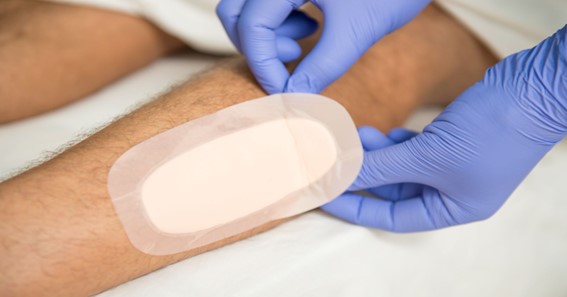Are you curious to know what is an occlusive dressing? You have come to the right place as I am going to tell you everything about an occlusive dressing in a very simple explanation. Without further discussion let’s begin to know what is an occlusive dressing?
In the field of wound care, occlusive dressings play a vital role in creating an optimal healing environment for various types of wounds. These specialized dressings create a barrier that covers the wound site, providing a range of benefits to promote healing and prevent complications. In this blog post, we will delve into the concept of occlusive dressings, their purpose, advantages, and common applications in wound care.
What Is An Occlusive Dressing?
Occlusive dressings are designed to create a seal or barrier over a wound, preventing air and moisture from reaching the affected area. These dressings are typically made of impermeable or semi-permeable materials that allow for the exchange of oxygen and moisture vapor, while preventing the entry of external contaminants.
Benefits Of Occlusive Dressings:
- Moist Wound Healing Environment: Occlusive dressings promote a moist wound healing environment, which has been shown to accelerate the healing process. By maintaining moisture at the wound site, these dressings create an optimal environment for cell growth, migration, and the formation of new tissue.
- Enhanced Healing And Reduced Scarring: Occlusive dressings help minimize scarring and promote the formation of healthy, granulated tissue. By providing a protective barrier, these dressings prevent excessive drying, reduce the risk of infection, and support faster wound closure.
- Reduced Pain And Improved Comfort: The occlusive nature of these dressings helps reduce pain and discomfort associated with wounds. By providing a barrier that protects nerve endings and keeps the wound site moist, occlusive dressings can contribute to enhanced patient comfort during the healing process.
- Prevention Of Infection: Occlusive dressings act as a physical barrier against external contaminants, including bacteria and other microorganisms. This helps minimize the risk of infection and allows for a sterile environment conducive to healing.
Common Uses Of Occlusive Dressings:
- Surgical Incisions: Occlusive dressings are commonly used to cover surgical incisions after various procedures. By providing a sterile and protected environment, these dressings aid in wound healing and reduce the risk of complications.
- Chronic And Acute Wounds: Occlusive dressings are utilized in the management of chronic wounds, such as pressure ulcers, diabetic foot ulcers, and venous leg ulcers. They can also be beneficial for acute wounds, including abrasions, lacerations, and burns, to promote faster healing.
- Topical Medication Delivery: Occlusive dressings can serve as a vehicle for delivering topical medications directly to the wound site. This enables targeted treatment and enhanced absorption of medications, maximizing their therapeutic efficacy.
- Cosmetic And Dermatological Procedures: In cosmetic and dermatological procedures, occlusive dressings may be used to protect skin grafts, promote healing after laser treatments or chemical peels, and improve the effectiveness of topical treatments.
Conclusion:
Occlusive dressings provide a range of benefits in wound care, creating a protective barrier that enhances healing, prevents infection, and improves patient comfort. By maintaining a moist wound healing environment and preventing external contaminants from entering the wound site, these specialized dressings contribute to faster healing, reduced scarring, and optimal recovery. Whether used for surgical incisions, chronic wounds, or cosmetic procedures, occlusive dressings play a crucial role in facilitating the healing process and promoting positive patient outcomes in the field of wound care.
Everything has its disadvantages on Disadvantagess you will get to know more.
FAQ
What Are Examples Of Occlusive Dressing?
- TYPES OF OCCLUSIVE DRESSINGS
5.1. Polymer Films. In 1960s, film dressings were introduced for wound management.
5.2. Polymer Foams.
5.3. Hydrogel Dressings.
5.4. Hydrocolloid Dressings
5.5. Alginates.
What Is An Occlusive Dressing Usually Used For?
Occlusion has clearly been proven to aid in the healing of superficial wounds and should be considered as a treatment alternative for wounds in the sports medicine setting. In this paper, I discuss three of the most widely used types of occlusive dressings: 1) films, 2) hydrogels, and 3) hydrocolloids.
What Is An Occlusive Wound Dressing?
A dressing is said to be “occlusive” if a moist wound surface is maintained when the dressing is in place. Occlusive dressings prevent wound desiccation by inhibiting the transmission of water vapor from the wound surface to the atmosphere.
What Is The Difference Between Occlusive And Nonocclusive Dressing?
The method of dressing ranges from totally occlusive where the gauze is completely covered by adhesive plaster to non-occlusive where light gauze dressing is held in place by few tape strips
I Have Covered All The Following Queries And Topics In The Above Article
What Is An Occlusive Dressing Used For
What Is An An Occlusive Dressing
What Is An Occlusive Dressing Made From
What Is The Advantage Of An Occlusive Dressing?
What Are Examples Of Occlusive Dressings
What Is An Occlusive Dressing Used For
Non Occlusive Dressing
Is A Band Aid An Occlusive Dressing
Is Tegaderm A Occlusive Dressing
Occlusive Dressing Taped On 3 Sides
Occlusive Dressing For Chest Wound
What Is An Occlusive Dressing
What is an example of an occlusive dressing
What is occlusive dressing?
